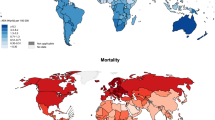Abstract
Background: A recent report noted a fourfold risk of ocular melanoma associated with employment in occupations involving use of cellular telephones. Methods: To aid interpretation of this finding, and clarify how subsite-specific temporal variation in incidence of ocular melanoma compares with that for cutaneous melanoma, we examined time trends in the incidence of melanoma among whites in the United States, based on data collected through the surveillance, Epidemiology, and End Results (SEER) program for 1974–1998. Results: The incidence of ocular melanoma decreased over time in both sexes, with no indication of a recent increase during the 1990s. The annual percent change was −0.7% for males (95% confidence interval: −2.3, 0.9) and −1.2% for females (95% confidence interval: −2.5, 0.0). Time trends appeared to differ by subsite of ocular melanoma; rates were flat for the choroid, decreased for the ciliary body, and increased for the conjunctiva (among males only) beginning in the 1980s. In contrast, all subsites of cutaneous melanoma, including the face and adjacent areas, showed marked increases in incidence over the observation period. Conclusions: The dramatic increase in use of cellular telephones has not been accompanied by an increase in the incidence of ocular melanoma. Further study is required to explain the different time trends for subsites of ocular melanoma, and for ocular versus facial and other cutaneous melanomas.
Similar content being viewed by others
References
Pane AR,Hirst LW (2000) Ultraviolet light exposure as a risk factor for ocular melanoma in Queensland, Australia. Opthalmic Epidemiol 7: 159-167.
Vajdic CM,Kricker A,Giblin M, et al. (2001) Eye color and cutaneous nevi predict risk ofocular melanoma in Australia. Int J Cancer 92: 906-912.
Vajdic CM,Kricker A,Giblin M, et al. (2002) Sun exposure predicts risk ofocular melanoma in Australia. Int J Cancer 101: 175-182.
Egan KM,Seddon JM,Glynn RJ,Gragoudas ES,Albert DM (1988) Epidemiologic aspects ofuveal melanoma. Surv Ophthalmol 32: 239-251.
Tucker MA,Hartge P,Shields JA (1986) Epidemiology of intraocular melanoma. Recent Results Cancer Res 102: 159-165.
Holly EA,Aston DA,Char DH,Kristiansen JJ,Ahn DK (1990) Uveal melanoma in relation to ultraviolet light exposure and host factors. Cancer Res 50: 5773-5777.
Seddon JM,Gragoudas ES,Glynn RJ, et al. (1990) Host factors, UV radiation, and risk ofuveal melanoma. Arch Opthalmol 108: 1274-1280.
Tucker MA,Shields JA,Hartge P,Augsburger J,Hoover RN,Fraumeni Jr JF (1985) Sunlight exposure as risk factor for intraocular malignant melanoma. N Engl J Med 313: 789-792.
Horn EP,Hartge P,Shields JA,Tucker MA (1994) Sunlight and risk ofuveal melanoma. J Natl Cancer Inst 86: 1476-1479.
Li W,Judge H,Gragoudas ES,Seddon JM,Egan JM (2000) Patterns oftumor initiation in choroidal melanoma. Cancer Res 60: 3757-3760.
Guénel P,Laforest L,Cyr D, et al. (2001) Occupational risk factors, ultraviolet radiation, and ocular melanoma: a case-control study in France. Cancer Causes Control 12: 451-459.
Scotto J,Fraumeni JF Jr,Lee JAH (1976) Melanomas ofthe eye and other noncutaneous sites: epidemiologic aspects. J Natl Cancer Inst 56: 489-491.
Schwartz SM,Weiss NS (1988) Place ofbirth and incidence of ocular melanoma in the United States. Int J Cancer 41: 174-177.
English DR,Armstrong BK,Kricker A,Fleming C (1997) Sunlight and cancer. Cancer Causes Control 8: 271-283.
Lerman S (1986) Sunlight and intraocular melanoma. N Engl J Med 314: 712-713.
Houlston RS,Damato BE (1999) Genetic predisposition to ocular melanoma. Eye 13: 43-46.
Stang A,Anastassiou G,Ahrens W,Bromen K,Bornfeld N,JÖckel K-H (2001) The possible role ofradio-f requency radiation in the development ofuveal melanoma. Epidemiology 12: 7-12.
Inskip PD (2001) Frequent radiation exposures and frequencydependent effects: the eyes have it. Epidemiology 12: 1-4.
Ries LAG,Eisner MP,Kosary CL, et al., eds. (2001) SEER Cancer Statistics Review, 1973-1998. Bethesda, MD: National Cancer Institute. (http://seer.cancer.gov/PublicationsCSR1973_1998/).
Percy C,Van Holten V,Muir C, eds. (1990) ICD-0, International Classification of Diseases for Oncology, 2nd edn. Geneva (Switzerland): World Health Organization.
Inskip PD,Tarone RE,Hatch EE, et al. (2001) Cellular-telephone use and brain tumors. N Engl J Med 344: 79-86.
Funch DP,Rothman KJ,Loughlin JE,Dreyer NA (1996) Utility oftelephone company records for epidemiologic studies of cellular telephones. Epidemiology 7: 299-302.
Frequently Asked Questions &; Fast Facts: How Many People Use Wireless Phones? Washington DC: Cellular Telecommunication Industry Association, 2001 (See: http://www.wow-com.com) Accessed June 17, 2002.
Millington RJ (1997) Mobile and personal communications in the 90s. In: Kuster N,Balzano Q,Lin JC, eds. Mobile Communications Safety. New York, NY: Chapman and Hall, 3-9.
Johansen C,Boice Jr JD,McLaughlin JK,Christensen HC,Olsen JH (2002) Mobile phones and malignant melanoma ofthe eye. Br J Cancer 86: 348-349.
Ferry AP (1964) Lesions mistaken for malignant melanoma of the posterior uvea. Arch Ophthalmol 72: 463-469.
The Collaborative Ocular Melanoma Study Group(1990) Accuracy ofdiagnosis of choroidal melanoma in the collaborative ocular melanoma study. Arch Ophthalmol 108: 1268-1273.
Shields JA,McDonald PR (1974) Improvements in the diagnosis ofposterior uveal melanoma. Arch Ophthalmol 91: 259-264.
Freire JE,Brady LW,DePotter P, et al. (1997) Eye. In: Perez CA,Brady LW, eds. Principles and Practice of Radiation Oncology. Philadelphia: Lippincott-Raven Publishers, pp. 867-888.
Iscovich J,Ackerman C,Andreev H,Pe'er J,Steinitz R (1995) An epidemiological study ofposterior uveal melanoma in Israel, 1961-1989. Int J Cancer 61: 291-295.
Cohen VM,Dinakaran S,Parsons MA,Rennie IG (2001) Transvitreal fine needle aspiration biopsy: the influence ofintraocular lesion size on diagnostic biopsy result. Eye 15 (pt 2): 143-147.
Østerlind A (1987) Trends in incidence ofocular malignant melanoma in Denmark 1943-1982. Int J Cancer 40: 161-164.
Strickland D,Lee JAH (1981) Melanomas ofthe eye: stability of rates. Am J Epidemiol 113: 700-702.
Jemal A,Devesa SS,Hartge P,Tucker MA (2001) Recent trends in incidence ofcutaneous melanoma in the United States. J Natl Cancer Inst 93: 678-683.
Sun E,Fears TR,Goedert JJ (1997) Epidemiology ofsquamous cell conjunctival cancer. Cancer Epidemiol Biomarkers Prev 6: 73-77.
Ateenyi-Agaba C (1995) Conjunctival squamous cell carcinoma associated with HIV infection in Kampala, Uganda. Lancet 345: 695-696.
Goedert JJ,CotÉ TR (1995) Conjunctival malignant disease with AIDS in USA. Lancet 346: 257-258.
Author information
Authors and Affiliations
Corresponding author
Rights and permissions
About this article
Cite this article
Inskip, P.D., Devesa, S.S. & Fraumeni, J.F. Trends in the incidence of ocular melanoma in the United States, 1974–1998. Cancer Causes Control 14, 251–257 (2003). https://doi.org/10.1023/A:1023684502638
Issue Date:
DOI: https://doi.org/10.1023/A:1023684502638




